Design education for kids and young people
Aalto’s Design Inside initiative and Aalto University Junior program collaborate for providing children with design understanding and skills.
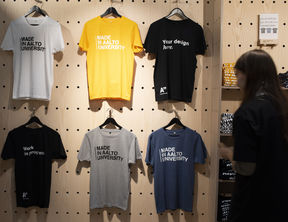
‘We all need understanding of design and its skills to create better and more human-centered solutions.Design has a crucial role in helping to find creative and unusual approaches to complex challenges we are facing now and in the future’, says Designer in Residence Andrea Bandoni, who is developing the embedding of design in education at Aalto.
Design is now firmly on the business agenda: there is already considerable evidence for it acting as an instrument for business growth and innovation. In recent years design has no longer been merely used for aesthetic or functional product decisions – it has gained relevance for the way organizations are structured, how they operate, and an increased number of companies have started to use design strategically.
In 2018, Aalto University launched Design Inside initiative, a strategic project that aims to spread design across the university, i.e. to science, business and technology studies.
The idea is to provide Aalto community the design tools and processes to meet the needs of the society and economy. The initiative co-creates, experiments and educates design-based practices for Aalto students, faculty and its partner networks. Thus Aalto wants to renew societies through creativity and world-leading design-based practices.
‘The key is to try understand other fields and then offer design content for them so that the design content is actually relevant for that specific field. We have been able to identify some of the areas of design that are more useful to teach to other fields like visualizations of knowledge, prototyping, service design understanding, user understanding and so on‘, sums up Bandoni the development at this phase.
The Design Inside initiative is part of Aalto University’s Arts and Creative Practices and involves also embedding design in Aalto’s strategy and partnerships collaboration, developed by designer in residence Enni Äijälä. The initiative is under supervision of professor Turkka Keinonen and senior specialist Teija Löytönen.
One of the project’s objectives is to embed design content in education in all areas, not just at the School of Arts, Design and Architecture. But how can that be done?
For students, Design Inside introduces iterative and explorative processes of working where the focus is not only in problem-solving, but also in problem definition by placing users and social issues in the center. They are provided with co-creation, team-working and visual and verbal communication skills.
Designer in residence Andrea BandoniIt is essential to understand different fields, so we can meet their field-specific needs and offer right tools."
‘Our goal is to provide at least an introduction on design in the different areas of the university. We have planned it together with the schools so we can meet field-specific needs. The solutions and models vary but the aim is the same: design is offered through education in all fields’, says Bandoni.
Bringing design elements into existing courses requires close cooperation with teachers. Design content is tailored for specific audiences and purposes. The focus of these collaborations is on the university’s mandatory bachelor courses, since they concentrate a high number of students in an initial phase and thus the impact is maximized. At the end of 2020 more than 1 000 students will have been affected by Design Inside educational activities.
There are or soon will be several courses with design content, both mandatory and elective, available at all of Aalto’s six schools. Pilots are made first, testing ideas and how the school could absorb the design content and integrate it in individual courses.
‘Many schools and teachers have a good and open approach, and at the same time there are some that need more work. But at Aalto people are very open to experimenting’, Bandoni explains.
In addition to the field-specific design courses, four discipline-free elective design courses are also being piloted and offered through University-Wide Art Studies (UWAS), an already existing platform for electives with a transdisciplinary and pedagogically experimental approach. The courses are Service Design with Emerging Technologies; From Idea to Shelf: Design for the Aalto University Shop; 3D Prototyping in the Context of Creative Practice and Integrated Design Thinking.
A few courses including design content started early last year, so there are some first experiences to learn from and results already gained. All the courses and contents are being improved with feedback from students and teachers.
At School of Science, professor of practice Maria Clavert’s project coursehas the participation of professor Severi Uusitalo and lecturer Teppo Vienamo from the Department of Design. The mandatory course is for all third year bachelors, about 250 students yearly, and its design content includes user-centered design, prototyping, testing and feedback. Collaboration is already taking place for the third time this year.
‘Our topic is user-centered product development, and design is an integral part of that. It was obvious for us that we must invite teachers from design background to talk about prototyping and user-centered design’, says Maria Clavert, who has background in Aalto Design Factory.
The role of Design Inside has been to help the teaching team develop the course content, connect the right design teachers to the course and give feedback on students’ final works. The design teachers help focusing projects on the user perspective and also in making, testing and improving prototypes with users.
‘Science students are used to solve problems already defined, where instead, this course challenges them to find their own problems to solve. This means they will need a completely different mindset and new, creative tools. This is where design comes into place’, explains Andrea Bandoni.
In their feedback, students state that they have learned to think "out of the box" and gained confidence to work with open problems. They highlight creativity and innovation competencies as well as interdisciplinary teamworking skills as the main outcomes of the course.
‘Some of the students are questioning, however, if these skills are relevant for their future profession. In my opinion, all Aalto students need capabilities for innovation, and Design Inside has been very helpful in supporting that mission’, says Clavert.
At School of Electrical Engineering, contents and materials for senior university lecturer Salu Ylirisku’s mandatory course Electronics and Design Workshop, meant for all first year bachelors, have been developed together with the Design Inside initiative. The contents have included video interviews with designers as a base for reflective learning, as well as animations of user-centered design methods and tools used for the benefit of students’ projects.
Furthermore, at the School of Chemical Engineering professor Jouni Paltakari’s course had graphic designer Juuso Koponen helping students in visualizing knowledge. The students’ assignment was to make interviews with existing research groups at the school, then transform that knowledge to visual format that can be showcased as a poster in an exhibition.
A design workshop followed by individual guidance helped the students to get familiar with the poster format, understand how to balance information through images, graphics and text, and how to highlight important aspects in a clear, concise way.
‘Design Inside has gained a lot of insight so far’, says Bandoni. ‘The collaborations show us that if we want to integrate design content to other fields, we need to look at design from their perspective, be very humble and work on the preconceptions that usually come with each one’s background.’
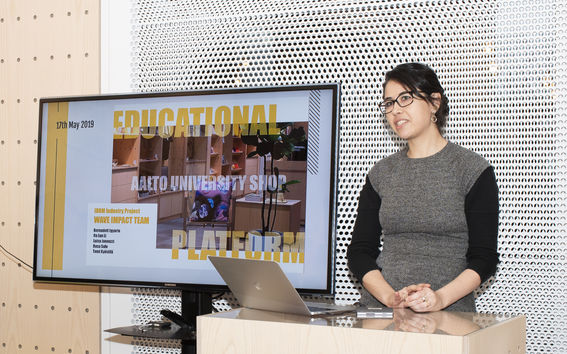
Since students at other schools don’t aim to be designers, there’s a need to find ways to attract them by clearly bringing value to the projects they need to complete in their own areas.
‘In this way, students will better understand design’s role and will be more open to collaborations and transdisciplinary projects in the future’, says Bandoni. ‘They might also want to deepen their knowledge on design, and take one of the many amazing courses that Aalto offers in the field.’
In the future, Bandoni hopes design tools and methods will be of easy access in any field so that everybody understands and can benefit from them. She sees the Design Inside initiative as an extraordinary experience for Aalto in implementing transdisciplinary education in the university’s reality, and in pushing innovation.
‘It is not easy because paths are not yet all clear, but it has never been tried this way before’, she says.
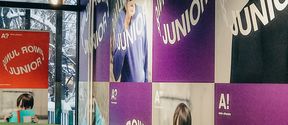
Aalto’s Design Inside initiative and Aalto University Junior program collaborate for providing children with design understanding and skills.
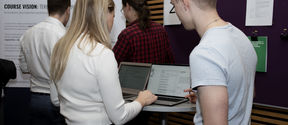
Design can add to business careers and recruitment processes benefit from user-centered design.
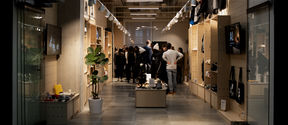
Multidisciplinary groups of students create intriguing and educative items for the shop – and for themselves.



